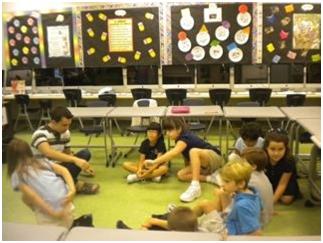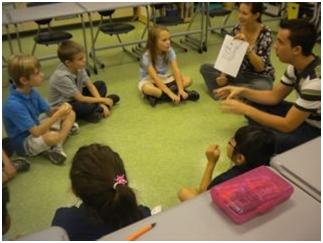ArtsBridge Scholars: Heather Ciano & Sarah Janus
ArtsBridge is a network of 31 universities that confronts the problem of the elimination of the arts from K-12 schools. The ArtsBridge projects in urban and low-income areas provide an alternative means to reach out to disadvantaged learners, particularly those with language acquisition delays. Under the direction of Dr. Lynnette Overby, who directs UD’s ArtsBridge Program, and in conjuction with the Undergraduate Research Program, Heather Ciano has been working on a research project entitled Poetry in Harmony, in which she explores how music can enhance both literacy and poetry curricula in an elementary school classroom. Her project, inspired by the recent budget cuts in arts education and unsatisfactory nationwide literacy skills, focuses on how a greater knowledge of music can influence students’ understanding of poetry and literacy techniques. Heather Ciano is a senior majoring in Human Services, with a focus on administration and family policy. Here, she explains her project in more depth.
Along with fellow ArtsBridge Scholar Jared Clough, I created six lessons separated into either two or three seg-ments, which involve both English topics and music standards for elementary school children. The targeted music concepts include rhythmic patterns, repeating patterns, dynamics, and musical instruments. These topics are being used to help students understand onomatopoeia, quatrains, haikus, rhyming, hard and soft letter sounds, descriptive words, and to also improve their reading comprehension skills. Jared and I teach lessons in which second-grade students sing songs, participate in group activities, create poetry, and perform in front of the class once a week. I hope that my project will add to the music and reading education literature, create greater appreciation for music, and continue to close the separation between the arts and academic curricula.
Community engagement such as this project have helped me develop my confidence in, determination for and love of learning as well as enriched my academic career. By spending time with children and using the arts in a unique way, I have developed skills I will use throughout my professional career. As I look towards graduation this spring and hopefully graduate work in occupational therapy in the fall, I know that I will take what I have learned through service learning opportunities such as ArtsBridge with me and apply them in my own classroom one day.
Sarah Janus is a sophomore majoring in History education. Her project, entitled Living History, strives to teach students about early American history and the basic elements of creative dance and drama. She describes her experience with the program in the following passage.

I have created four lesson plans that target key Social Studies, Dance, and Drama standards. These lessons endeavor to teach students about cause and effect, how to put events in chronological order, important historical figures during the American Revolution, how to study primary and secondary sources, and understanding change over time. In addition to these Social studies skills, students will also learn about basic locomotor and non-locomotor movements, levels and pathways, how to create and perform choreography, stage directions, and how to block a skit.
In general, I hope that the students will gain knowledge about both the arts and history, but more importantly about how to work together in groups. Each lesson plan involves group work and calls for the students to use team work to create a final project to perform for the class.
I believe that this service learning experience has been and continues to be a great outlet for my creative energy, but in a way that links the arts to my major. As a history education major and a dance minor, I enjoy working on a project that allows me to gain teaching, lesson planning, and work experience. I believe that my time spent with Artsbridge and the Undergraduate Research Program will help me in my career tremendously.
Student and Community Engagement Through the Arts
Yael Hernandez is a senior music education major. She is a McNair and ArtsBirdge Scholar. Her presentations during the McNair Scholars final program in summer 2009 was awarded a second place honor.
Music is part of life that transcends the senses and taps into what we as humans cannot see or understand in the physical. It is an art that has helped mold me into not only a musician, but the person I am today. The inspiration of music is what gave me the desire to become a teacher and share experiences with students that will shape them musically and personally. Because music has made such a prolific impact on my life, I decided my junior year of college to become involved with an opportunity to advocate for music education through research in the McNair Scholars Program.
Upon applying for this program, I was introduced to Dr. Lynnette Overby, an advocate for arts education. During our first meeting, Dr. Overby and I discussed interdisciplinary learning through the arts, a topic I took interest in but did not know much about. At the end of our meeting, she handed me an application for the ArtsBridge Scholars Program to become a part of teaching interdisciplinary learning through the arts in Delaware. This program changed my life as a teacher and musician and opened my eyes to the value of the arts in education.
As an ArtsBridge Scholar, I observed and taught children 4-5 years of age at the UD Early Learning Center. My experiences there were enriching not only for myself but the students. What encouraged me the most was the enthusiasm the students had towards learning through music activities. I can even recall the teacher letting me know how she would incorporate certain music activities into daily classroom lessons.
Through ArtsBridge, I was also given the privilege of traveling to California with Dr. Overby to attend the National ArtsBridge Conference. Here, I went through sessions that explored training in a curriculum entitled Reading in Motion. This curriculum was used to teach students of low-income status in the Chicago area how to read through the vehicle of music. I took an interest in teaching this curriculum; however, I was concerned about the way in which music was being incorporated as a tool for reading rather than in conjunction with reading. In other words, in the Reading in Motion curriculum, students do not acquire music knowledge while learning to read. Instead, they are expected to perform certain musical tasks such as clapping in time when they do not have the musical knowledge to do so efficiently.
After being accepted into the McNair Scholars Program, these issues lead to the formulation of my research topic for the summer—how the incorporation of early childhood music into the Reading in Motion curriculum will affect the acquisition of reading and music skills of young children. My experiences with researching articles and case studies of how music positively affected the academic and personal growth of children and witnessing this occur within my own pilot study was transformational. It was amazing to see how the students who interacted more with music progressed greatly in reading and music skills throughout the 3 ½ weeks of instruction.
Looking back, it is interesting to see how much my experiences with service learning through ArtsBridge lead me to conduct research in an area I would not have explored otherwise. Currently, I have been given the opportunity to continue doing research and service learning in schools with the Reading in Motion curriculum and Early Childhood Music (music learning and nurturing from ages birth to 5 years). In the future, I hope to develop a curriculum that uses Reading in Motion and Early Child-hood Music to tutor and teach emergent readers. I also plan to create a non-profit music conservatory in urban areas that will not only mold students musically, but also serve as a place where students can receive tutoring in various subjects through music. I am excited to continue experiencing the transformational effect music has within education!

SarahKim Vennard s completing a degree in Biology and senses coordination for the M.D. ArtsBridge Scholar Program.
The University of Delaware now hosts a chapter of the ArtsBridge National Scholar program, under the direction of Dr. Lynnette Overby. The program engages university students to write curricula for the use of fine and performing arts to teach core subjects. There are currently three projects in which UD students are going out to local elementary schools to teach. Reading in Motion uses music and rhythm to teach new readers, Creating Landscapes uses dance and creative movement to teach geography, and Transportation uses theater and dance to teach students about the progression of how we travel. Each is run as a scientific research project which pro-vides an excellent opportunity to experience the research process in arts and education sector.
These research projects brought with them many opportunities for travel and exciting experiences. Brittany Carson, Heather Silva and I worked on Creating Landscapes with students from two other universities, Brigham Young and North Texas, to create a full-length choreographic work entitled Human Kind. It merged images of the outer landscapes of our surroundings with the inner landscapes of personal narratives. We traveled to Utah for a week and worked with seven other dancers from the other schools. Each of us brought a deeply personal story to share and took creative risks in our composition of a ten-minute work. The creative process for the piece was intensely rewarding for every dancer involved. Human Kind was featured at the Dance and the Child International USA Conference in Provo, Utah in the summer of 2008. In addition to the performance, we shared their interdisciplinary work with others at the conference. Along with Dr. Overby, several other masters of arts integration attended the session and offered valuable input to our projects. In the spring, I traveled to University of California, Irvine to attend the ArtsBridge National Conference. Here, I presented the Creating Landscapes work for other arts-integrated educators from across the country. The topics explored throughout various ArtsBridge programs includes math and geometry in quilting, music in the Revolutionary War, dance as a commentary on cultural geography, and the scientific processes of various art media.
Several Scholars attended the National Dance Educator’s Organization (NDEO) Conference in New York City in June 2009. For five days, we stayed at an apartment in the East Village and attended workshops and lectures about dance and education. Brittany, Heather, and I presented The Creating Landscapes research to a packed room of dance educators, eager to hear about getting into the classroom. For the culminating activity, students worked with legendary dancer and choreographer Bill Evans to create a piece about generations which they performed at the closing ceremony.
Finally, in August 2009, Heather and I, along with newcomer Kimberly Schroeder, traveled to Denton, TX to rework Human Kind and then on to Kingston, Jamaica to the Dance and the Child International Conference. Here, in the beauty of the tropics, students and educators from all over the world gathered to share their love of dance. Reunited with former Human Kind cast members, we participated in master classes, workshops, lectures, and demonstrations about diverse styles of dance. Together, the entire cast aided in presenting the Creating Landscapes from both the arts-integration and the performance aspects. We particularly enjoyed receiving encouraging feedback from those from other countries where the performing arts are more prevalent such as Finland and Jamaica. We all built lasting friendships with those across the globe.
Developing Creating Landscapes as a program of ArtsBridge America at the University of Delaware has proved to be a rewarding experience for every Scholar involved. It brought many unique and challenging performance opportunities and a chance to travel across and even outside the country. We worked with several pioneers in the dance and education fields. The research produced by Creating Landscapes is valuable in the advocacy of arts integration in the school system, and seeing results in the classroom was immediately gratifying. Getting involved with Arts-Bridge America is a wonderful opportunity for experiential learning.